Microchip is the approved leader in 8-bit microcontrollers by continually investing and expanding upon the PIC® microcontroller lineup. Emphasis is persistently focused on reducing costs while developing products with a strong mix of peripherals such as LCD drive, PWM, ADC, comparators, timers and communication.
Beyond standard peripherals, Microchip is constantly bringing additional value to PIC and AVR microcontrollers by developing unique and exclusive peripherals. These unique peripherals allow embedded engineers to simplify their designs and create ever more creative applications and products. This innovation is demonstrated by some of the following microcontroller integrated peripherals. This innovation is best demonstrated by microcontrollers with Core Independent Peripherals.
CIPs allow the peripherals to operate independently of the core, including serial communication and analog peripherals.
Together with the Event System, that allows peripherals to communicate without using the CPU, applications can be optimized at a system level. This lowers power consumption and increases throughput and system reliability.
PIC Microcontrollers with Core Independent Peripherals take 8-bit MCU performance to a new level. With a number of on-board modules designed to increase capability in any control system, these MCUs represent the best value in embedded design.
Core Independent Peripherals Key Attributes
 Self-Sustaining
Self-Sustaining
Once initialized in a system, Core Independent Peripherals can provide steady-state closed loop embedded control with zero intervention from the MCU’s core. The CPU can then be idled or put into SLEEP mode to save system power.
Significant Savings
By taking the load off the CPU, Core Independent Peripherals allow smaller, lower power PIC MCUs to perform extremely complex tasks, such as high power lighting control and communication. In addition, significant BOM cost savings can be realized by replacing off-board discrete components with these integrated peripherals.
CPU Free
Core Independent Peripherals are smartly interconnected to allow near zero latency sharing of data, logic inputs, or analog signals without additional code or interruption of the CPU. This frees the CPU to perform other system tasks and reduces Flash memory consumption.
 Each peripheral has been crafted to work both individually and in tandem with other parts of a MCU to enable commonly used tasks with minimal supervision from the core processor. This allows a PIC and AVR MCU to support as many system functions as possible, while minimizing the use of external components and the need for power-hungry resources. Our function enablement approach helps reduce system cost and can increase an end product’s performance and robustness. Core Independent Peripherals are available in both 8 bit microcontrollers from PIC10, PIC12, PIC16, PIC18 families, as well in ATmega AVR series. The presentation continued with a short presentation of each Core Independent Peripheral, including key features, benefits and potential application areas.
Each peripheral has been crafted to work both individually and in tandem with other parts of a MCU to enable commonly used tasks with minimal supervision from the core processor. This allows a PIC and AVR MCU to support as many system functions as possible, while minimizing the use of external components and the need for power-hungry resources. Our function enablement approach helps reduce system cost and can increase an end product’s performance and robustness. Core Independent Peripherals are available in both 8 bit microcontrollers from PIC10, PIC12, PIC16, PIC18 families, as well in ATmega AVR series. The presentation continued with a short presentation of each Core Independent Peripheral, including key features, benefits and potential application areas.
16-bit Pulse Width Modulation (16-bit PWM)
High Resolution with Independent Time Base High with no processing required by the MCU core.
 Features
Features
• Period, Phase, Duty Cycle and Offset control
• PWM Modes
– Standard
– Center Aligned
– Configurable Set/toggle on timer match
• Flexibility when using multiple PWM Outputs
– Use of offset registers to stagger outputs
• Selectable internal or external clock source
• Dedicated 16-bit Time Base
– Four compare modes
– Useable as a general purpose 16-bit timer/counter
• Paired with the DSM to create LED dimming engine
Benefits
• Reduced EMI using Center Aligned
• Intelligent PWM Reconfiguration
• Use interrupts to trigger events
• Precise duty cycle control
– Smaller step size
– Smoother transitions
• Core independent operation
Angular Timer (AngTMR)
Automatically converts timed based events to degrees with no processing required by the MCU core.
Features
• Automatically provides phase angle conversion for control of rotational and periodic events
– Ex. Motor, AC Mains, TRIAC, etc.
 • Converts time based signals to degrees
• Converts time based signals to degrees
• Generates interrupts based on angles
• Detects missed events
• Simplified code development
– Program in terms of degrees
– Automatically adjusts for frequency changes
– Simplifies math required
Benefits
• Increased accuracy
• Improved performance
• Reduced code size
• Core independent operation
• Operation while in low power SLEEP
Configurable Logic Cell (CLC)
The CLC provides programmable combinational and sequential logic. It also enables on-chip interconnection of peripherals and I/O, thereby reducing external components, saving code space and adding functionality.
Features
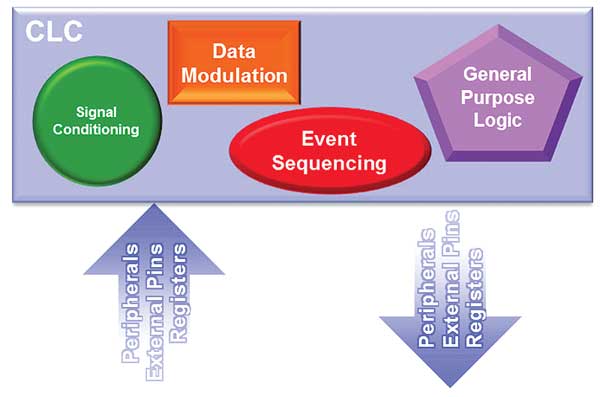 • Combinational Logic Functions
• Combinational Logic Functions
– AND/OR/XOR/NOT/NAND/NOR/XNOR
• State Functions / Clock
– D & JK Flip-flops, D & SR Latch’s
• Customizable logic with run time control
• Up to 32 external or internal input sources
• Output to external pins or internal peripherals
• Configuration via Microchip Code Configurator (MCC)
Benefits
• Increases on chip interconnectivity
• Reduces component count and PCB area
• Fast event response
• Core independent operation
• Operation while in low power SLEEP
Cyclic Redundancy Check (CRC/Scan)
The CRC/Scan peripheral provides automated CRC polynomial generation and verification of Program / DATA Memory to test for Non Volatile Memory Integrity. It can also be configured to provide 16-bit CRC for use with memory and communications data.
Features
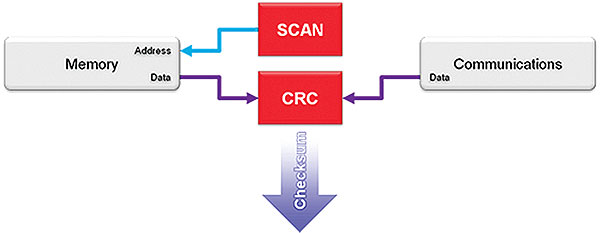 • General purpose 2-bit to 16-bit CRC
• General purpose 2-bit to 16-bit CRC
– For use with memory and communications data
• Automated CRC checksum with background SCAN
– Program memory
– DataEE memory
• Calculates CRC checksum on communications data
• Configurable polynomial (all standard CRC implementations)
• Corruption is detected upon checksum mismatch
• All memory scan operations are controlled via software
Benefits
• Increased code and data integrity
• Software configurable for easy updates and modifications
• Eases implementation of safety standards (ex. Class B, UL, etc.)
• Core independent operation
• Operation while in low power SLEEP
Complementary Waveform Generator (CWG) Complementary Output Generator (COG)
The CWG provides a complementary waveform with rising and falling edge dead band control, enabling high efficiency synchronous switching, with no processor overhead. The CWG also incorporates auto shutdown, auto restart, and can interface directly with other peripherals / external inputs. The COG improves upon the functionality of the CWG with the addition of blanking and phase control.
 Features
Features
• Various input sources inclusive of: Comparators, PWM, CLC, NCO
• Blanking control for transient filtering (COG only)
• Polarity control
• Phase control for output delay (COG only)
• Auto shutdown/restart
• Independent rise and fall
• Dead band control
High Endurance Flash (HEF)
The High-Endurance Flash is a block of 128 memory locations, found at the top of the Flash program memory that is ensured to provide a superior endurance, equal to that of a traditional data EEPROM.
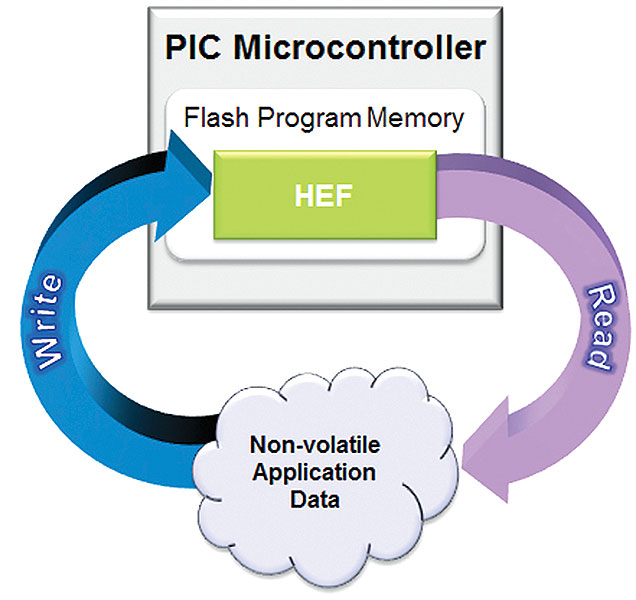 Features
Features
• High Endurance Flash (HEF)
• 128 B of non-volatile data memory
• Shared with flash program memory
• 100 K E/W cycle high endurance flash
Benefits
• Provides non-volatile data storage
• Low cost alternative to EEPROM
• Robust data storage and durability
Example Uses
• Data logging
• Look-up tables
• Configuration and calibration settings
Math Accelerator (MathACC)
The Math Accelerator offers completely Core Independent calculations, with the capability to perform 16-bit math and PID operations. Offloading these functions leaves the CPU free to perform other system tasks, consumes less program memory, and reduces the overall power consumption of the MCU.
Features
 • General purpose MATH & PID functions
• General purpose MATH & PID functions
• MULTIPLY, ADD, ACCUMULATE functions
• 8-bit/16-bit values with 35-bit result
• Four Operation Modes
• Multiply and Accumulate (MAC)
• Add and Multiply
• Simple Multiplier
• Signed and un-signed multiplies
• Programmable PID Controller
• 16-bit PID function based on configurable Kp, Ki, Kd constants with a 34-bit result
Benefits
• Speeds up math performance
• Reduces code size
• Accelerates PID control
• Core independent operation
Numerically Controlled Oscillator (NCO)
Precision Linear Frequency Generator
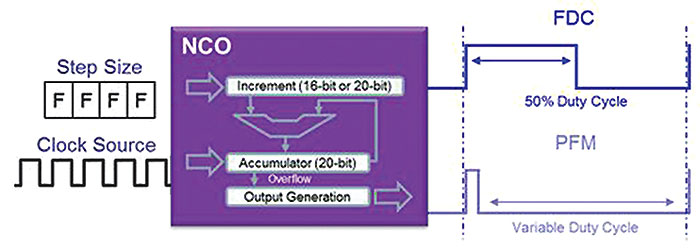 Features
Features
• 16-bit numeric frequency control
– 500 kHz max output
• 20-bit numeric frequency control
– 32 MHz max output
• 0.0001% step size of source clock input frequency
• Multiple Clock Sources
• Operation while in low power SLEEP
• Two output modes
– Fixed 50% duty cycle
– Pulse Frequency Modulation
• Useable as a general purpose 20-bit timer/counter
• True linear frequency control
• Increased frequency resolution
• Core independent operation
Peripheral Pin Select (PPS)
I/O pin remapping of digital peripherals for greater design flexibility and improved layout.
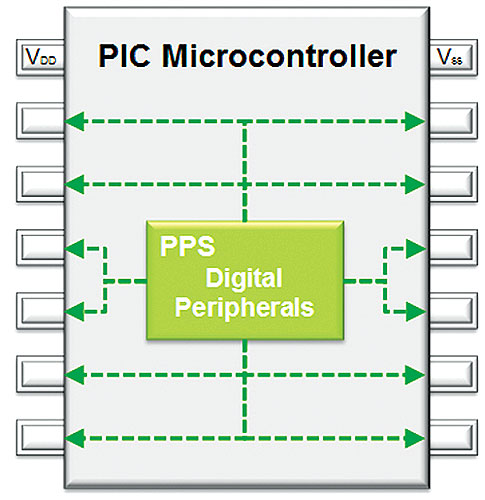 Features
Features
• Configure any digital peripheral to any I/O pin
• Flexible pin function assignment
• Runtime configuration of pin out
• Provides increased freedom and optimized use of integrated digital resources
• Route peripheral to multiple pins to increase current drive
Benefits
• Eliminates “pin overlap” for total optimization of peripheral resources
• Simplified and optimized migration
• Provides layout flexibility
Programmable Switch Mode Controller (PSMC)
The PSMC is a high performance 16-bit PWM with 6 configurable outputs that can operate in multiple modes. With a dedicated 64MHz clock and the flexibility to interface to external inputs as well as integrated peripherals / clock sources, the PSMC offers the highest level of advanced PWM control and accuracy in an 8-bit MCU. The PSMC can simplify the implementation of a wide array of applications such as: motor control, lighting, and power supplies.
Features
• 16-bit PWM with up to 6 configurable outputs
• Various clock sources: external, system clock, independent 64 MHz oscillator
• Various input sources: comparators, external pins, other peripherals
• Flexible PWM output modes
• Blanking control for transient filtering
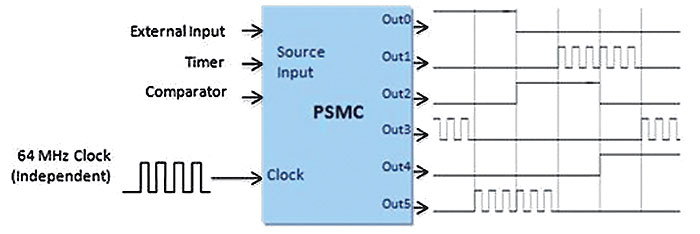 • Independent rising/falling edge control
• Independent rising/falling edge control
• Dead band with independent rise and fall control
• Polarity control/auto shutdown and restart
• Output Gating – externally control activate/deactivate
Output Modes/Target Applications
• Single Phase PWM (+comp)
– Stepper Motor Control
– Brushed DC Motor Control
– Power Supplies
• ECCP Compatible Full Bridge PWM
– Brushed DC Motor Control
• Push-Pull PWM (+Comp Out)
– Half and Full Bridge Power Supplies
– Synchronous Drives
• Pulse Skipping PWM (+Comp Out)
– High Efficiency Converters
– Voltage mode Controllers
• Push-Pull PWM w/4 Full Bridge Outputs (+Comp Out)
– DC to AC Inverters
– Class-D Output Drives
– Induction Motor Drives
• Variable Freq – Fixed Duty Cycle PWM (+Comp Out)
– Resonant Converters
– Fluorescent Dimming Ballasts
• 3-Phase PWM
– 3-Phase BLDC motors
– AC Inverters
24-bit Signal Measurement Timer (SMT)
The Signal Measurement Timer (SMT) is a 24-bit counter with advanced clocking and gating logic, which can be configured for measuring a variety of digital signal parameters such as pulse width, frequency and duty cycle, and the time difference between edges on two signals.
Features
• Accurate measurement of any digital signal
– Period, pulse width, frequency, duration, duty cycle, time of flight, etc.
• High resolution 24-bit signal measurement
• Provides relative timing measurements
• Multiple interrupt sources
 – Period match, measure period, pulse width
– Period match, measure period, pulse width
– (2) Data Capture interrupts
• Flexible input source sources
• Useable as a general purpose 24-bit timer
• Useable as a custom digital protocol decode
Benefits
• Code size reduction
• Faster response to changing inputs
• Core independent operation
• Operation while in low power SLEEP
Temperature Indicator (TempIND)
Low Cost Temperature Measurements with no processing required by the MCU core
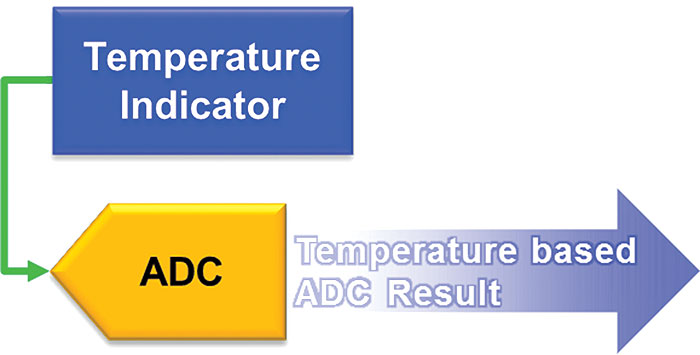 Features
Features
• Provides integrated temperature measurements
• Absolute accuracy ±5°C
• Measure between –40°C and 85°C
• Internally connected to ADC
• ADC result changes with TEMP
Benefits
• Low cost TEMP measurements
• No external hardware
• Improved RTC accuracy over TEMP
• Core independent operation
• Operation while in low power SLEEP
Windowed Watch Dog Timer (WWDT)
The Windowed Watch Dog Timer is a system supervisory circuit that generates a reset when software anomalies are detected within a configurable 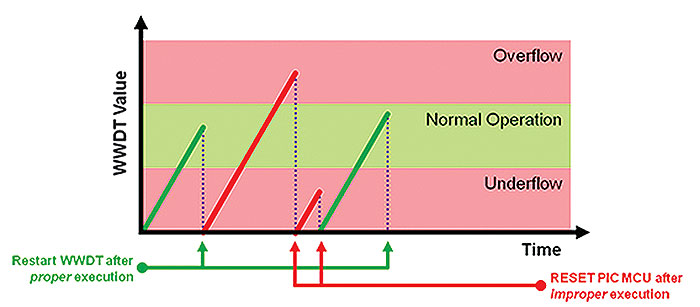 critical window.
critical window.
Features
• Detects software timing anomalies within a configurable critical window
• Supports standard watch dog timer functions
• Resets the CPU if…
– the WWDT overflows (standard WDT function)
– the WWDT underflows
Benefits
• Monitors timing critical functions
• Core independent operation
• Eases implementation of safety standards (ex. Class B, UL, etc.)
• Operation while in low power SLEEP
Hardware Limit Timer (HLT)
The Hardware Limit Timer (HLT) provides a timed hardware limit to be used in conjunction with asynchronous analog feedback applications, or to detect missed periodic events.
Features
• Hardware monitoring for missed periodic events and fault detection (stalls, stops, etc.)
• Period timer with external reset input
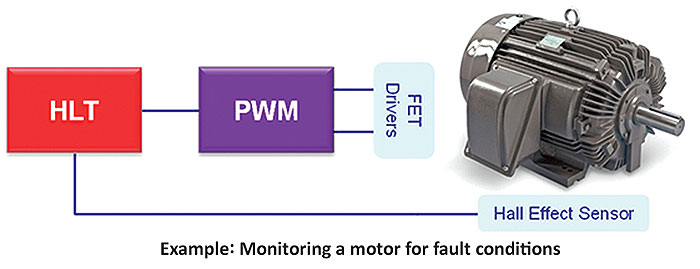 • Resolution of ¼ instruction cycle
• Resolution of ¼ instruction cycle
• Flexible design
– Selectable start of event trigger
– Multiple modes
– Seven available clock sources
• Useable as a general purpose 8-bit timer/ counter with external reset capabilities
Benefits
• Core independent operation
• Operation while in low power SLEEP
• Reduces code complexity
– No code for detection set-up
– No code to manage timer
For more detailed information, products selection and Application Notes regarding 8-bit MCU with Core Independent Peripherals, please visit: www.microchip.com/cip
Free Your Creativity with Core Independent Peripherals!
Author: Ilko Radulov, Field Application Engineer, Comet Electronics, ilko.radulov@comet.bg
Comet Electronics
www.comet.bg
www.comet.srl.ro
www.comet.rs




